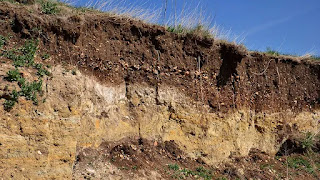Granular structure
Structure made of lentil-sized grains of soil
A granular structure refers to a physical or material configuration that is composed of or characterized by small, distinct particles or grains. These particles are typically in a loose arrangement, with spaces between them, giving the material a grainy or particulate texture. Granular structures are common in nature and in various human-made materials. The term can be used in a variety of fields, including geology, material science, and physics, to describe both natural formations and engineered substances.Key Characteristics of Granular Structures:
- Discrete Particles: A granular material consists of individual, distinct particles or grains, which may vary in size and shape.
- Loose Packing: The particles are not bonded together in a rigid structure; instead, they are loosely packed, often with air or voids between them.
- Flowability: Granular materials can often flow and shift depending on external forces, like gravity, making them behave differently than solid, rigid materials.
- Surface Area: Granular materials typically have a large surface area relative to their volume due to the small size of the particles.
Examples of Granular Structures:
- Sand: One of the most common examples of a granular structure, sand consists of tiny grains of rock or mineral particles. These grains are loose and can easily move, making sand a highly flowable material.
- Gravel: Gravel is composed of larger particles than sand, but it also forms a granular structure. Its individual stones or pebbles can be easily separated, and it can be used in construction and road-building.
- Sugar: Granulated sugar consists of small crystals of sucrose arranged in a granular structure, where individual sugar grains can flow and settle.
- Cereals: Many dry cereals are composed of small granules that form a granular structure, allowing them to be easily poured or handled.
Granular Structure in Geology:
- Granular Rocks: Some rocks have a granular texture, such as granite, where individual mineral grains (e.g., quartz, feldspar) can be seen. These rocks form from the cooling and crystallization of molten material.
- Soils and Sediments: Granular structures are also common in soils and sediments, such as sandy soils, where the particles are loose and allow water to pass through more easily compared to more compacted or cohesive materials like clay.
Granular Materials in Engineering and Physics:
- Granular Flow: Granular materials like sand, grains, and powders exhibit interesting flow properties. When subjected to forces like vibration or gravity, these materials can flow, compact, or pile up. This is why granular materials behave differently from liquids and solids. Engineers study granular flow to understand phenomena like avalanches, landslides, or the behavior of powders in industrial processes.
- Granular Matter: This refers to systems that consist of large numbers of particles that interact via collisions or friction. Granular matter is studied in physics to understand how materials transition between solid-like and fluid-like behavior under different conditions.
- Granular Materials in Industrial Processes: Industries often deal with granular materials in bulk, such as coal, grains, cement, and pharmaceuticals. The handling, transportation, and processing of granular materials are critical in many industries, requiring specialized equipment and techniques to control flow and behavior.
Granular Structure in Materials Science:
In materials science, a granular structure can refer to the microstructure of materials, where the grains or particles are arranged in distinct patterns. This structure influences the material's properties, such as its strength, durability, and thermal conductivity. The study of granular structures is important for developing materials with specific qualities.
Applications of Granular Structures:
- Civil Engineering: Granular materials like gravel, sand, and crushed stone are fundamental in construction for making foundations, roads, and drainage systems.
- Pharmaceuticals: Granular structures are used in the production of pills and tablets, where the granules are compressed to form solid doses.
- Food Processing: Many food products, such as sugar, salt, and rice, are processed into granular forms for easier handling, storage, and use.
Granular Materials vs. Other Types of Materials:
- Granular vs. Solid: Unlike solid materials, which have tightly packed particles, granular materials have space between the particles and can often flow or shift under the right conditions.
- Granular vs. Liquid: Granular materials are different from liquids in that they do not flow smoothly or uniformly. Instead, they exhibit a "discrete" or "non-continuous" flow, where the particles can jostle and move around each other.
Granular Structure in Nature and Everyday Life:
- Soil Composition: Soil often contains granular particles, such as sand, silt, and clay, and its texture (whether it is coarse or fine) determines how water and air move through the soil.
- Snow: Snow can have a granular structure, especially when the snow is old or has been compressed. Snowflakes, in their individual forms, also represent a type of granular structure in nature.
Conclusion:
Granular structures are composed of small, discrete particles that form a loose, often flowable material. These structures are widely observed in natural formations, such as sand and gravel, as well as in manufactured materials, such as granulated sugar and powders. Understanding granular structures is important in fields like geology, materials science, engineering, and physics, as the behavior of granular materials often differs from that of solid or liquid substances.











Hiç yorum yok:
Yorum Gönder
Yorumunuz İçin Teşekkürler